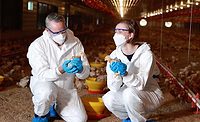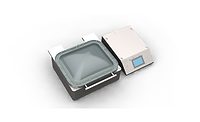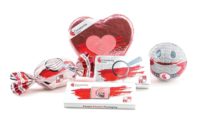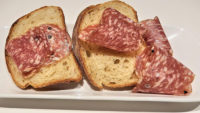Achieving peak food safety and a long shelf life can be accomplished with the right combination of packaging materials and technology—especially during a pandemic.
Best practices for peak food safety
“Safety is top of mind for consumers and when it comes to food, it’s an expectation. Plastic packaging plays a critical role in food protection—delivering and extending the safety and quality of the food we eat throughout the supply chain,” says Michelle Sauder, senior marketing manager, Dow’s Food and Specialty Packaging division, Midland, MI.
Packaging is designed to protect the product by keeping contaminants away from the food, and providing appropriate barriers to against moisture-vapor and oxygen transmission to extend the quality of the food inside, she says.
“When it comes to addressing food safety, we must consider the journey that food takes from farm to fork. The earlier in that process that food is packaged, the more protected it will be from exposure to the outside world,” Sauder explains.
“One good example is the shift we’ve seen in the way that meat is packaged. Historically, meat was shipped in large cuts to the grocery stores, to be processed and wrapped in the back of the store. Today, case-ready packaging is the norm. Meat is being cut and packaged at the meat plant, which eliminates extra handling and processing of the meat at the store. The less contact, the better for shelf life and quality. The shift to case-ready packaging was enabled by better, tougher packages that can endure shipping and offer extended shelf life,” she notes.
Another important factor in keeping food safe is the right packaging format and structure, Sauder continues.
“Take sealant choice as an example. Sealant can offer tamper evidence, eliminate leaks and maintain the right internal packaging conditions. One example from our portfolio is SURLYN, which has high perforation resistance, abrasion resistance and oil resistance, helping keep even tough food applications protected, like bone-in meats,” she states.
It is important to highlight that protection should not be necessarily translated into more packaging, she advises.
“The advancements on packaging materials and production processes allowed packaging designers to produce packaging structures that are hermetic, strong and with high barrier—often composed of a single type of material, which favors its recyclability.”
Larry McGill, CEO, KanPak, Wichita, KS, recommends aseptic processing.
“Owned by our facility’s cross-functional qualified food safety teams, a risk-based food safety plan governs KanPak’s aseptic process. Aseptic processing creates a product that is free from microbiological organisms and placed in a hermitically sealed package, eliminating the need for refrigeration or preservatives to maintain quality and safety through the shelf life,” he explains.
Dharmendra Mishra, Ph.D., assistant professor, department of food science, Purdue University, says that best practices for shelf-stable high-acid or acidified food products—for example, salsa or hot sauce—are manufactured using the hot-fill-hold method to ensure longer shelf life.
“On the other hand, shelf-stable low acid products—[like] chocolate milk or ready-to-drink coffee—are manufactured using either a retort technology or by aseptic processing and packaging. In aseptic processing, the product and package are sterilized separately and then sealed in an environment (aseptic filler) free of microorganisms. Product produced with this method could last 9-15 months.”
Megan Fletcher, market development manager, Ossid, Battleboro, NC, says that as a food packaging equipment manufacturer, they consider food safety to be a top priority for all equipment they have in the industry.
“Food sold at retail stores as well as to foodservice providers must be packaged in a clean, sanitary, and safe environment. Ossid equipment is designed to package products with the highest level of standards in the industry, including many IP65 wash down rated machines,” she notes.
“Most of our equipment is self-operating after set-up, reducing the opportunity for contamination to occur at the packaging level. In addition, preventative maintenance scheduling built into our machines also reduces the risk of issues to occur within the packaging stage. Well-designed and operating equipment is a must when it comes to food safety.”
Thomas Eck, SVP operations, Constantia Flexibles, Vienna, Austria, says that best practices start with the beginning of the development of a new packaging structure, by choosing the right raw materials and processes, which is called “Designing for compliance.”
“It also implies a close upfront cooperation and information exchange with suppliers to have best knowledge about raw materials. In addition, it is essential to have an intensive cooperation between the packaging manufacturer and the food producer regarding the type of food, packaging lines or storage conditions,” he says.
Moreover, not only the implementation of a CIP (Continuous improvement program) is fundamental but also a positive approach towards auditors (HSSE, risk analysis and risk control) to permanently improve production processes, Eck adds.
“Last but not least, hygiene, microbiology and pest management is of utmost importance,” he notes.
Best practices for long shelf life
Sauder says that packaging for extended shelf life and food safety require similar considerations.
“It’s an important consideration for brand owners looking to give consumers the confidence of a longer expiration date. Ensuring a long shelf life is really aimed at reducing food waste as brand owners provide a higher number of purchase and consumption opportunities. The role of packaging on food protection and shelf life extension is even more critical when combined with other consumer demands as fresher food and clean label,” she explains.
Spoilage and waste issues vary by food type and across the value chain steps, Sauder says.
“According to a 2020 study, published in the American Journal of Agricultural Economics, the average U.S. household wasted 31.9 percent of its food. The total annual cost of the wasted food was estimated to be $240 billion or $1,866 per household,” she adds.
Each food type has unique requirements to optimize its shelf life, with some requiring to be isolated from external environment, others to regulate packaging internal gas composition. Packaging materials must be carefully chosen to meet these requirements, Sauder advises.
“We offer our ELITE AT family of resins, which are designed for dry food packaging and stand-up pouches, providing excellent moisture barrier, heat resistance and stiffness—all important factors for shelf life and shelf stability. These resins increase snack food shelf life by maintaining freshness longer and keeping moisture out of food packages like granola, cereals, snacks and chips that can go stale without proper protection.”
It’s also critical to mention the importance of recyclability in food packaging, Sauder notes.
“At Dow, we are working to minimize food waste and packaging waste. We work with customers and brand owners to put recyclability at the core of product design, with technologies like our RETAIN compatibilizer, which can create a recyclable high barrier packaging solutions through the combination of moisture barrier polyethylene compositions with typical oxygen barrier resins as EVOH and using RETAIN compatibilizers at proper dosage for posterior mechanical recycling.”
Eck says that a long shelf life can be ensured by defining requirements, properties of required packaging and seal integrity.
“It is important to assure inertness and long term stability towards food ingredients. Furthermore, raw materials have to be selected carefully to ensure for appropriate barrier properties of the food ingredients processes and targeted shelf life. On customer request, suitability for sterilization processes can be provided and again the microbiology and hygiene conditions have to be controlled.”
McGill says that KanPak’s best practices for a long shelf life center on aseptic processing technology.
“The process of Ultra High Temperature (UHT) processing allows the product to be treated at extremely high temperature for a validated (and very short) amount of time to destroy any natural bacterial load the product might contain. The short amount of time spent at this temperature allows our products to maintain the desired flavor and color profile that appeal to consumers,” he says.
“Given the sterile nature of the product, we can store and distribute product in an ambient environment with longer shelf life than products requiring refrigeration to control microbial growth. Depending on the product and packaging, our products have between 5 and 18 months of shelf life.”
Fletcher says that food shelf life varies drastically by the type of food being packaged, the shipping conditions, the retail environment and finally, the end user environment.
“To ensure food has a long shelf life, many forms of packaging must be considered in order to find the best solution for a particular product. Some items require high barrier films and reduced oxygen in the package to prolong shelf life, while other products require breathable film in order to maintain product freshness,” she explains.
Ossid equipment can run a wide variety of films including breathable produce or poultry films, lidding films for gas flushing, to vacuum skinning films in which oxygen is removed from the package, Fletcher says.
“As an equipment manufacturer, we stay up to speed on a wide variety of industry materials best suited for each product need.”
Changes due to COVID-19
“The COVID-19 pandemic is impacting life around the world and Dow is doing its part to keep our employees safe,” says Sauder. “We are closely tracking the impacts of COVID-19 to understand how consumer behaviors and expectations are changing.”
If anything, the pandemic has allowed Dow to leverage its experts and resources in new ways to help front line workers, Sauder notes.
“For example, in April we announced an open source design for a simplified face shield and donated 100,000 face shields to hospitals in Michigan. We’re happy to have the opportunity to collaborate internally and externally with partners, in order to help in unprecedented and difficult times like this.”
McGill says that in response to rapid, unexpected supply chain changes due to COVID-19, KanPak recently launched a surplus milk bottling initiative.
“Just as dairy cows approached the height of their milk production season this past spring, farmers were dumping excess milk. We couldn’t stand by and see surplus food go to waste with more people struggling with food security and economic hardships increasing. So, KanPak acted quickly, innovating around a new product, developing new packaging and driving speed-to-market in about a month’s time.”
New product launches typically take at least three to four months, including approvals, package design, and protocols, he explains.
“From food manufacturing and distribution to non-profit partnerships and vendor collaboration, KanPak leveraged expertise, infrastructure, and relationships from across the GSF family of companies and beyond to kick-start this initiative we were able to cut the time to market in half.”
McGill says that their customers’ and consumers’ safety is at the heart of its food safety systems.
“We have watched the FDA closely and have followed the guidance related to COVID-19, highlighted by the lack of evidence that food is a vector of transmission. We have followed the CDC’s guidelines around social distancing, practicing safe, healthy hygiene, increased facility cleanliness, participating in our company’s temperature screening practice, or working remotely when possible, we’re focused on taking care of each other while supporting our customers and our businesses effectively.”
Fletcher says that Ossid’s packaging formats have not changed as far as what they can provide customers with, but they have seen an increase in ready meal type of applications.
“We believe this is because consumers are looking for easier, safer options for to-go type of meals and less interaction with others if possible. Another area we are seeing change is the fresh produce department. There are concerns with shoppers touching vegetables and fruit and thus we have seen an increase in overwrap produce packaging. This provides a layer of film protection between the consumer and the product, while still providing great product visibility, as well as the option for retailers to sell a bundle of product.”
Best practices have certainly changed in regards to the spacing of plant workers, the need to wear mask and checking temperatures, says Fletcher.
“Typically, food processors practice very good hygiene with frequent hand washing and wearing gloves, although this may be monitored more closely now.”
Mishra says that COVID-19 has certainly changed the usual handling of products in commercial manufacturing.
“There are heightened sanitation practices with use of gloves, face masks and face shields to avoid any cross contamination. There are mandatory temperature checks for the employees, maintaining social distancing by eliminating extra seatings, labeling seating locations for employees and increased frequency of sanitation and cleaning,” he notes.
Other things to reduce contamination are more hand sanitation stations, visitor policy changes, touch point and exposure analysis and post COVID concern policy of there is a suspect case, Mishra says.
“The internal packages surface gets sterilized during the food processing; however, the external surface needs to be taken care of before it gets packed in cases for distribution and shipping. Conveyor belts are regularly sanitized to reduce or eliminate the risk of contamination.”
Eck says that Constantia Flexibles did not change any packaging specifications due to COVID-19, but that in their production plants, hygienic measures are on a high level. These measures include:
- Disinfect fluids are available at the locations entrances, in office-areas and at/around workplaces where hand-wash with water/soap is not easily possible.
- Implement distancing rules for canteens and locker rooms (less seats).
- There is no open buffet in the canteen anymore and a schedule in slots to reduce the number of people at the same time was implemented.
- Additional and more frequent cleaning by using Coronavirus-relevant agents in locker rooms, showers, canteen, restrooms.
- Frequent disinfection of critical contact-points and -surfaces like handrails, door-handles, touch-screens/control panels, forklifts, locker rooms, etc.
- Prevent unnecessary access to other departments or offices of the workers location.
- Reduce potential contacts during shift-changes while ensuring transfer of information (repair, incident, ...)
- Ensure provision of "Questionnaire for Visitors" to 3rd-party/essential technical services, truck-drivers, and so on to be filled.
- Plants need to provide additional/temporary lavatory for truck-drivers; they are not allowed to enter the shop floor / office and have to wait outside (or in the vehicle)
- Wearing of masks (as well as mouth-nose-protection) is mandatory when distance rules cannot be observed
- Temperature-checks for all persons entering the plant
New packaging materials and technologies
“On June 17, 2020, Dow announced it is developing new post-consumer recycled (PCR) resins, which will be offered worldwide. Notably, the recycled plastic resins are geared to harness the resources of used plastic packaging to create new packaging materials, thereby reducing waste. The new offering of PCR resins is part of Dow's comprehensive strategy to develop a circular plastics economy by focusing on incorporating recycled content into product offerings,” says Sauder.
Some of its other recent advancements include a partnership with the Fuenix Ecogy Group for a new feedstock made from recycled plastic waste to produce new polymers, she notes.
“Fuenix has been providing Dow with a new feedstock made from recycled plastic for polymer production at Dow’s Terneuzen facility in the Netherlands. The process breaks down mixed waste plastics into their original form to manufacture virgin polymers. The polymers produced will be identical to products from traditional feedstocks and can be used in the same applications.”
Dow has been partnering with UPM in Europe to source renewable bio-naphtha made from tall oil (a paper industry waste residue) and use it to make renewable PE for customers and brand owners, too, she says.
“With growing interest in renewable feedstock-based PE across the globe, we plan to expand this play into Asia as well,” adds Sauder.
GEA began sales of the GEA OxyCheck, first introduced at IPPE (International Production & Processing Expo) in Atlanta in January 2020, after receiving approval from the FDA.
OxyCheck is the world’s first in-line measurement system that can check the oxygen content and seal integrity of every single package in a modified atmosphere packaging line. With GEA OxyCheck, every MAP (Modified Atmosphere Package) is non-invasively inspected for oxygen content after sealing on a GEA thermoformer. Up until now, packages had to be damaged by a probe and testing was limited to a small sample coming off the line. The demo version, initially presented in North America during 2018, has already been utilized in Europe with great success.
“OxyCheck will be an important add on to our thermoforming equipment. Large customers have already shown interest and are waiting for the new technology. At IPPE we will show our new thermoformer, the GEA PowerPak PLUS together with the GEA OxyCheck. Both have been developed to make the customer’s packaging job easier, which means more efficiency, improved package quality, reduced film consumption, and simple handling, as well as safe process sequences and greater availability,” says Steve McGady, GEA head of equipment sales, slicing and packaging, North America.
McGill says that KanPak’s customers continue to look for ways to cut costs and reduce waste. That’s why KanPak works to provide new packaging technologies that include portion control options and longer product shelf life.
“Currently, we’re working on film packaging variations that deliver significant reductions in the amount of materials used. Many of our suppliers also provide us with bulk totes and plastic pallets that we return to them for re-use, which advances our efforts towards zero waste.”
Eck says that Constantia Flexibles’ main product launches within this year were “EcoLam” and “EcoPaper.”
“The EcoLam family consists of three main specifications: EcoLam, EcoLamPus and EcoLamHighPlus. The main difference between the three product lines is the increased barrier properties against oxygen and water vapor,” he explains.
EcoLam’s special structure fullfills many advantages that are demanded in a modern world, Eck says.
“It is oriented Mono-PE laminate applicable in a broad variety of packaging applications, fully recyclable and as a side effect also has a feel-good factor to the consumer from purchasing a recyclable packaging product.”
EcoPaper is the new paper packaging solution for food and non-food products. As EcoPaper is consisting of coated paper, it is widely recyclable in the paper-waste stream while ensuring the barrier needs of [ingredients like] chocolate, Eck notes.
Fletcher says that Ossid has been working with several suppliers on new sustainable packaging material options to run on its existing equipment.
“Over the past year we have seen a significant rise in recyclable or compostable materials, and these new materials are not always compatible with existing equipment and can take numerous testing cycles to perfect the materials. We work diligently with our material suppliers to ensure that our equipment has the capability to run these new materials, so that our customers can be the first to go to market with them,” she adds.
“Our patented technology on several machines also allows us to run less film than competitors, enabling a huge savings to the customer. We are always up to speed on anything new in the works, and we hope to share something new in equipment with you soon.”
Related - Slideshow: Packaging materials and technologies for peak food safety and long shelf life








